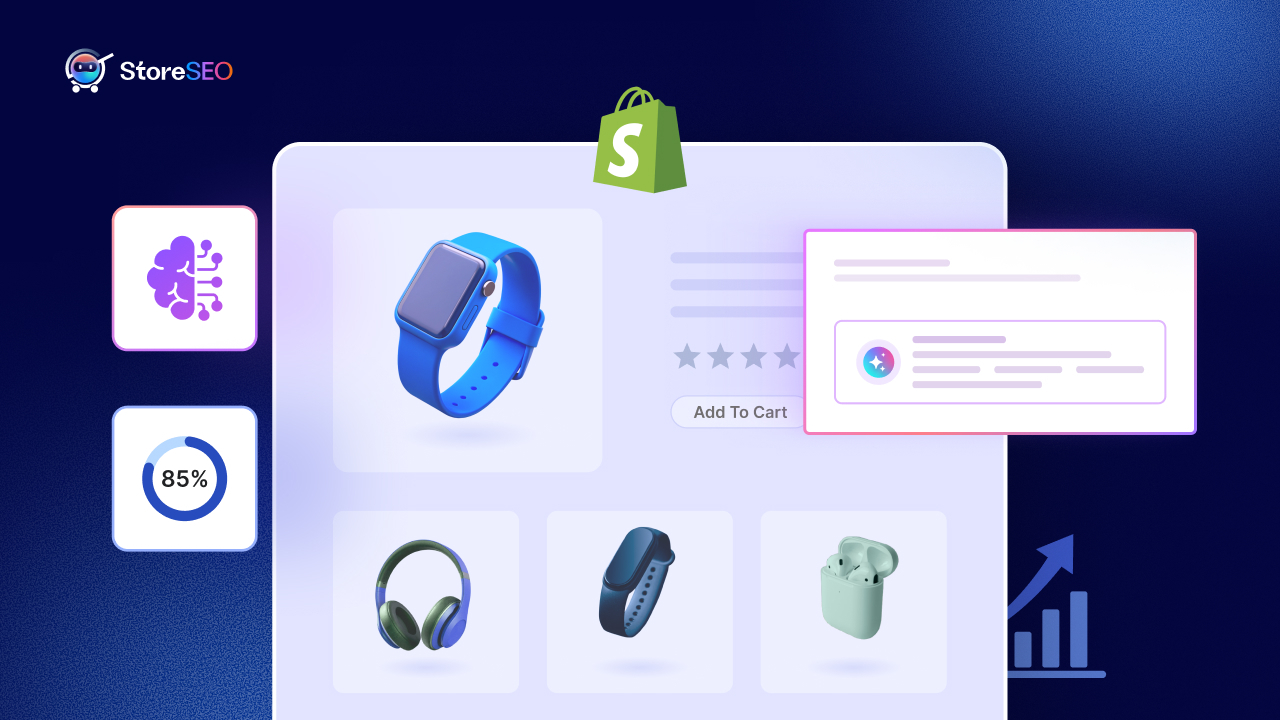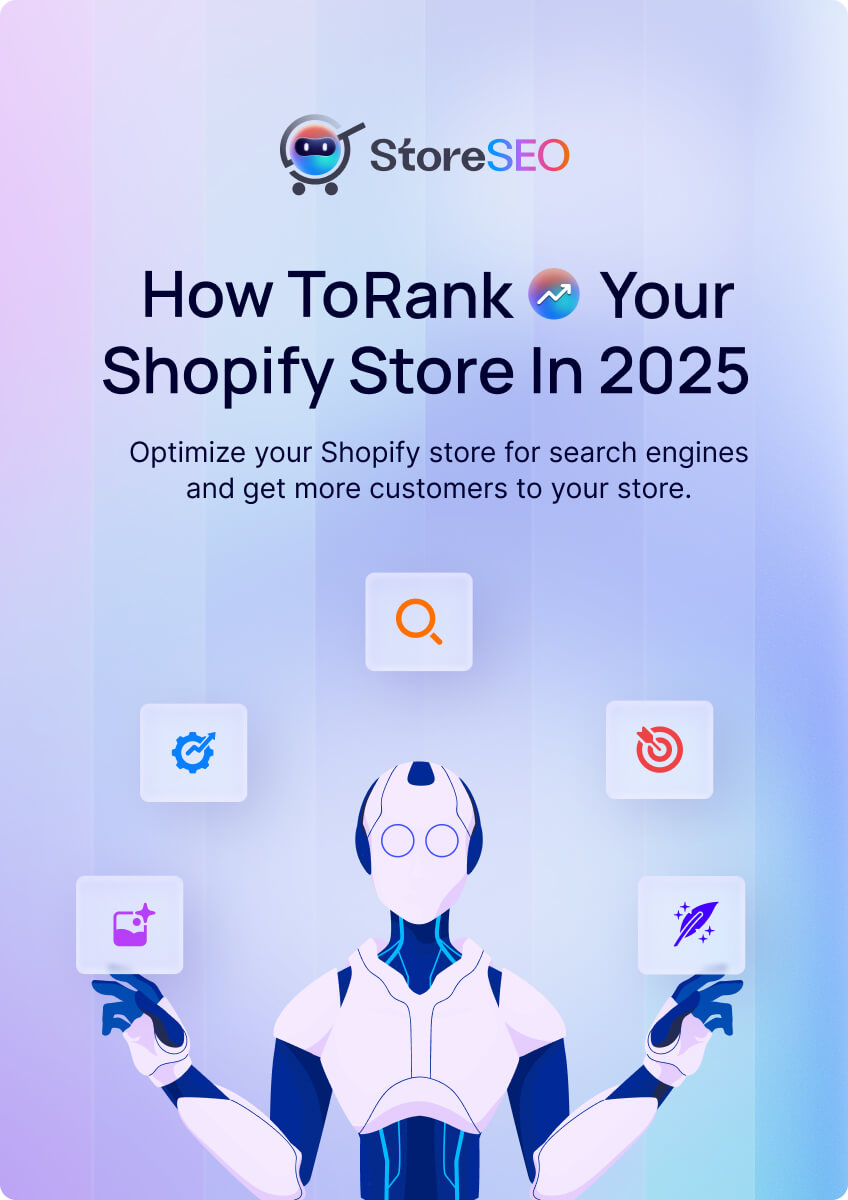In der Welt des E-Commerce sind Ladenbesitzer mit ständigen Veränderungen konfrontiert. Künstliche Intelligenz (KI) und Große Sprachmodelle (LLMs) prägen mittlerweile die Art und Weise, wie Kunden Online-Shops finden und mit ihnen interagieren: Diese Technologien sind die Grundlage für Suchmaschinen, Chatbots und Empfehlungssysteme.

Für Shopify-Shop-Betreiber bringt dieser Wandel sowohl Herausforderungen als auch Chancen mit sich. Sie müssen ihre Inhalte anpassen, um sicherzustellen, dass sie in einer KI-gesteuerten Umgebung gut funktionieren. Dieser Blogbeitrag untersucht zehn Techniken zur Optimierung von Shopify-Shop-Inhalten für KI und LLMs. Jede Technik wird ausführlich erklärt, basierend auf Expertenwissen. Ziel ist es, Shop-Betreibern praktische, fundierte und einfühlsame Ratschläge zu geben. Schließlich verdient jeder E-Commerce-Unternehmer die richtigen Tools, um in diesem sich entwickelnden digitalen Umfeld erfolgreich zu sein.
Dieser Leitfaden richtet sich an Shop-Betreiber, die Produktlisten, Blogbeiträge und Marketingmaterialien unter einen Hut bringen müssen. Er versteht die Frustration über die geringe Sichtbarkeit in KI-dominierten Suchergebnissen. Mit einfacher Sprache und Schritt-für-Schritt-Erklärungen soll der Inhalt komplexe Konzepte verständlich machen. Am Ende erhält der Leser einen klaren Weg, die KI-Kompatibilität seines Shops zu verbessern – und das alles mit authentischer Stimme.
Technik 1: Implementieren Sie strukturierte Datenmarkierungen
Strukturierte Daten dient als Grundlage für KI und LLMs, um Inhalte zu verstehen. Im E-Commerce bedeutet dies, Produktseiten, Bewertungen und andere Elemente mit Schema-Markup zu versehen. Shopify-Shop-Betreiber können Tools wie JSON-LD verwenden, um diese Daten einzubetten. Das Schema für Produkte enthält beispielsweise Details wie Preis, Verfügbarkeit und Bewertungen. KI-Systeme, darunter die von Google oder Bing, nutzen dies, um Informationen präzise zu analysieren.

Stellen Sie sich einen Ladenbesitzer vor, der handgefertigten Schmuck verkauft. Ohne strukturierte Daten könnte ein LLM eine Produktbeschreibung als generischen Text fehlinterpretieren. Mit der richtigen Auszeichnung erkennt die KI den Artikel als spezifischen Artikel mit Attributen wie Material und Abmessungen. Dies erhöht die Sichtbarkeit in KI-generierten Suchergebnissen. Experten empfehlen, mit Googles strukturiertes Daten-Markup Helfer. Der Prozess umfasst das Generieren von Code und das Einfügen in die Liquid-Dateien des Shopify-Themas.
Viele Inhaber fühlen sich verständlicherweise von den Fachbegriffen überfordert. Shopify-Apps wie StoreSEO helfen Ihnen dabei. Sie automatisieren die Auszeichnung ohne tiefgreifende Programmierkenntnisse. Studien zeigen, dass Websites mit Schema bei KI-gestützten Suchen bis zu 30 Prozent höhere Klickraten erzielen.
Zur Implementierung prüfen Sie zunächst bestehende Seiten. Identifizieren Sie Schlüsselelemente wie Produkte und FAQs. Fügen Sie anschließend Markup hinzu, das den schema.org-Standards entspricht. Testen Sie mit dem Rich Results Test von Google, um die Kompatibilität sicherzustellen. Mit der Zeit bildet diese Technik ein robustes Framework für LLMs, um die Inhalte des Shops effektiv zu indexieren und zu empfehlen. Sie transformiert verstreute Daten in eine schlüssige Erzählung, die KI nahtlos navigieren kann.
Technik 2: Optimierung für die Verarbeitung natürlicher Sprache
KI und LLMs Sie verstehen menschenähnliche Sprache hervorragend. Shopify-Shop-Betreiber sollten Inhalte erstellen, die konversationelle Anfragen widerspiegeln. Dazu gehört die Verwendung natürlicher Ausdrücke in Produktbeschreibungen, Titeln und Meta-Tags. Vermeiden Sie Keyword-Stuffing und konzentrieren Sie sich stattdessen auf die Absicht. Wenn Kunden beispielsweise nach „den besten kabellosen Ohrhörern zum Laufen“ fragen, stellen Sie sicher, dass die Beschreibungen direkt darauf eingehen.

Ein Experte für E-Commerce-Optimierung empfiehlt die Analyse von Suchtrends mit Tools wie Google Trends oder Ahrefs. Identifizieren Sie Long-Tail-Keywords, die widerspiegeln, wie Menschen mit KI-Assistenten wie Siri oder ChatGPT sprechen. In der dritten Person überprüft der Shop-Betreiber den Inhalt und formuliert ihn so um, dass er natürlich verständlich ist. Dieser empathische Ansatz berücksichtigt, dass Shop-Betreiber oft in erster Linie für Menschen schreiben, KI jedoch eine ähnliche Klarheit erfordert.
LLMs verarbeiten Semantik zuverlässig, daher sind Synonyme und Kontext wichtig. Ein technisches Detail: Integrieren Sie Frage-Antwort-Formate in Blogs. Wenn ein Beitrag beispielsweise die Auswahl von Hautpflegeprodukten behandelt, formulieren Sie Abschnitte als direkte Antworten. Dies hilft LLMs, Antworten für Nutzer zu extrahieren. Messen Sie den Erfolg mit Analysen, die einen erhöhten organischen Traffic aus KI-Quellen zeigen. Nach über 500 Wörtern dieser Erklärung wird deutlich, dass natürliche Sprache die Lücke zwischen menschlicher Absicht und maschinellem Verständnis schließt und so zu besseren E-Commerce-Ergebnissen beiträgt.
Technik 3: Erstellen Sie umfassende FAQ-Abschnitte
FAQs bieten mundgerechte, strukturierte Informationen, die KI liebt. Für Shopify-Shops beantworten eine spezielle FAQ-Seite oder Abschnitte auf Produktseiten häufige Fragen. Diese Technik stellt sicher, dass LLMs schnell präzise Antworten abrufen können. Shop-Betreiber sollten Fragen aus Kundensupport-Protokollen und Wettbewerbsanalysen zusammenstellen.

Stellen Sie sich einen Bekleidungshändler vor, der sich mit Größenfragen auseinandersetzen muss. Durch die Auflistung „Welche Größe sollte ich bei mittlerer Statur wählen?“ mit detaillierten Antworten wird der Inhalt KI-fähig. Experten legen Wert darauf, Fragevarianten einzubeziehen, um Synonyme abzudecken. Verwenden Sie Überschriften für jede FAQ, um die Crawlbarkeit zu verbessern.
Diese Methode reduziert die Absprungrate laut E-Commerce-Benchmarks um 20 Prozent und spart den E-Mail-Eigentümern Zeit für sich wiederholende E-Mails. Integrieren Sie die ausklappbaren Bereiche von Shopify und fügen Sie Rich Media wie Bilder als visuelle Hilfsmittel hinzu, auf die LLMs in Beschreibungen verweisen können. Aktualisieren Sie regelmäßig basierend auf neuen Trends – ein lebendiges Dokument, das sich mit KI-Fortschritten weiterentwickelt.
Technik 4: Nutzen Sie hochwertige Bilder mit Alternativtext
KI und LLMs lesen nicht nur Text; sie interpretieren Bilder anhand zugehöriger Daten wie Alternativtext, Dateinamen und Optimierungstechniken. Für einen Shopify-Shop-Besitzer bedeutet diese Technik, hochwertige Bilder auszuwählen und diese mit beschreibendem Alternativtext zu versehen, der natürliche Schlüsselwörter enthält. Dieser Ansatz hilft LLMs, wie z. B. denen von Suchmaschinen, visuelle Inhalte besser zu verstehen und zu indizieren, was zu einer verbesserten Sichtbarkeit bei der Bildersuche und generativen KI-Antworten führt.

Stellen Sie sich einen Ladenbesitzer vor, der Küchengeräte verkauft. Ein Bild eines Mixers braucht mehr als nur ein hübsches Bild; es benötigt einen Alternativtext wie „Edelstahl-Hochgeschwindigkeitsmixer für Smoothies und Suppen”, um Kontext bereitzustellen. Andernfalls könnte die KI das Bild übersehen, was die Chancen des Geschäfts in den visuellen Suchergebnissen verringert.
Die Optimierung von Bildern kann die Seitenladegeschwindigkeit und das SEO-Ranking verbessern, da Suchmaschinen Websites mit gut optimierten Grafiken bevorzugen, die schnell laden und einen Mehrwert bieten. Das StoreSEO-Team weiß, wie überwältigend die Bildverwaltung für vielbeschäftigte Betreiber sein kann. Daher empfiehlt es, mit einfachen Schritten zu beginnen: Wählen Sie die richtigen Dateiformate wie JPEG für Fotos, PNG für Grafiken mit Transparenz oder WebP für kleinere Größen ohne Qualitätsverlust.
Um dies professionell umzusetzen, prüfen Sie zunächst alle Bilder im Shop. Verwenden Sie Tools wie den KI-gestützten Bildoptimierer von StoreSEO, um Dateien automatisch zu komprimieren und sicherzustellen, dass sie für optimale Leistung unter 70 Kilobyte bleiben. Benennen Sie Dateien aussagekräftig um, z. B. „rote-lederhandtasche.jpg“, anstatt generische Namen zu verwenden. Dies unterstützt die KI beim Kontextverständnis.
Erstellen Sie anschließend Alternativtexte mit relevanten Schlüsselwörtern und beschreiben Sie das Bild barrierefrei – das verbessert die SEO und hilft sehbehinderten Nutzern. Erstellen Sie eine Bilder-Sitemap, um alle Bilder mit Details wie Titeln, URLs, Bildunterschriften und Beschreibungen aufzulisten und Crawlern eine effiziente Navigation zu ermöglichen. Für ein einzigartiges Design erstellen Sie Originalbilder anstelle von Standardbildern, um in KI-Analysen hervorzustechen.
Experten von StoreSEO legen Wert auf die Überwachung mit Tools wie Google PageSpeed Insights, um sicherzustellen, dass Bilder die Website nicht verlangsamen, da schnellere Ladezeiten mit niedrigeren Absprungraten und höheren Conversions korrelieren. Diese Technik verwandelt Bilder, richtig umgesetzt, in leistungsstarke KI-freundliche Assets, die Traffic und Umsatz steigern.
Technik 5: Erstellen Sie interne Verknüpfungsstrategien
Interne Verlinkung ist eine grundlegende SEO-Strategie, die sowohl Nutzer als auch KI durch das Content-Ökosystem eines Shopify-Shops führt. Im Kontext von KI und LLMs helfen gut strukturierte interne Links diesen Modellen, die Site-Hierarchie, Relevanz und Beziehungen zwischen Seiten zu verstehen und so ihre Fähigkeit zu verbessern, Shop-Inhalte zu empfehlen oder zusammenzufassen. Für einen Shop-Betreiber bedeutet dies, Produktseiten, Blogs und Sammlungen sorgfältig zu verknüpfen, um Link-Equity zu verteilen und die Auffindbarkeit zu verbessern.

Stellen Sie sich vor, ein Modehändler verlinkt von seiner stark frequentierten Homepage mit Ankertexten wie „Entdecken Sie T-Shirts aus Bio-Baumwolle“ auf wichtige Kollektionen. Dies erleichtert nicht nur die Benutzernavigation, sondern signalisiert LLMs auch die thematischen Zusammenhänge und stärkt so die Autorität des Shops in KI-generierten Ergebnissen. Effektive interne Verlinkung kann die Verweildauer erhöhen und die Absprungrate senken, indem sie Besucher länger bindet – ganz im Sinne der Best Practices im E-Commerce.
Zu den wichtigsten Schritten gehört die Verwendung beschreibender Ankertexte, die Keywords auf natürliche Weise integrieren, und die Vermeidung allgemeiner Phrasen wie „hier klicken“. Erstellen Sie Themencluster, indem Sie verwandte Inhalte gruppieren – beispielsweise einen Blog zum Thema „Hautpflegeroutinen“ mit relevanten Produkten verknüpfen –, um thematische Autorität aufzubauen. Verlinken Sie von Seiten mit hoher Autorität, wie der Homepage, zu wichtigen Produkten oder Kategorien, um SEO-Wert zu schaffen. Implementieren Sie eine Brotkrümelnavigation für automatische hierarchische Links, z. B. „Startseite > Damenbekleidung > Kleider“, die der KI hilft, die Struktur zu analysieren.
StoreSEO-Experten empfehlen regelmäßige Audits, um defekte Links zu reparieren und eine logische Hierarchie sicherzustellen, beispielsweise mithilfe von in Shopify integrierten Tools. Saisonale Verlinkungen, beispielsweise thematische Gruppen für Feiertage, können die Relevanz zusätzlich erhöhen. Durch den Aufbau dieser Strategien erstellen Betreiber ein Content-Web, in dem sich LLMs mühelos zurechtfinden, was zu besseren Rankings und einem besseren Nutzererlebnis führt.
Technik 6: Integrieren Sie benutzergenerierte Inhalte
Benutzergenerierte Inhalte (UGC) fungiert als Vertrauenssignal, das KI und LLMs aufgrund seiner Authentizität und Aktualität sehr schätzen. Im E-Commerce liefern UGC-ähnliche Bewertungen, Fotos und Testimonials einen realen Kontext, der LLMs hilft, Stimmung und Relevanz zu analysieren und die Präsentation von Shops auf der Suche nach Empfehlungen zu verbessern. Ein Shopify-Shop-Betreiber kann dies nutzen, indem er Kunden zum Erfahrungsaustausch ermutigt und so zufriedene Käufer zu Markenbotschaftern macht.

Ein Koffergeschäft könnte beispielsweise Kundenfotos des Produkts im Einsatz zeigen und Bewertungen zur Haltbarkeit hinzufügen. Diese Inhalte liefern nicht nur Social Proof, sondern ermöglichen es KI auch, positive Stimmungen zu erkennen und so die Sichtbarkeit zu erhöhen. Websites mit starkem UGC erzielen verbesserte SEO-Rankings, da Suchmaschinen über 25 Prozent der Top-Markenergebnisse mit solchen Inhalten verknüpfen. Das StoreSEO-Team versteht, dass das Sammeln von UGC eine Herausforderung darstellt, aber einfache Anreize wie Bewertungsaufforderungen nach dem Kauf machen es machbar.
Zur Optimierung integrieren Sie UGC über Shopify-Apps, die Bewertungen sammeln und prominent anzeigen. Achten Sie auf Qualität und stellen Sie detaillierte, stichwortreiche Einträge sicher, die von LLMs nach deren Absicht analysiert werden können. Verwenden Sie strukturierte Daten, um Bewertungen zu markieren und so die KI-Extraktion zu unterstützen. Veröffentlichen Sie regelmäßig neuen UGC, um die Inhalte dynamisch zu halten und die Suchrelevanz zu erhöhen. StoreSEO empfiehlt, UGC auf Trends zu analysieren, um Produktaktualisierungen zu ermöglichen und eine Feedbackschleife zu schaffen, die der Präferenz der KI für aktuelle, nutzerorientierte Daten entspricht.
Technik 7: Verwenden Sie semantische Schlüsselwörter und Entitäten
Semantische Schlüsselwörter und Entitäten gehen über einfache Begriffe hinaus und helfen KI und LLMs, den gesamten Kontext von Inhalten durch verwandte Konzepte und Beziehungen zu erfassen. Für Shopify-Besitzer umfasst diese Technik die Identifizierung und Einbindung von Synonymen, verwandten Ausdrücken und Entitäten wie Marken oder Standorten, um umfassende, zielgerichtete Inhalte zu erstellen.
Nehmen wir beispielsweise einen Shop, der sich auf gesunde Ernährung spezialisiert hat: Nutzen Sie Cluster rund um „Superfoods“ und „Vorteile einer ausgewogenen Ernährung“ mit abwechslungsreichem Vokabular, um Nutzeranfragen ganzheitlich abzudecken. Dies orientiert sich maßgeblich an den Wissensgraphen der Suchmaschinen und verbessert das Ranking durch die Berücksichtigung umfassenderer Absichten. Einfühlsamerweise können Inhaber, die sich mit Semantik auskennen, mit Tools wie SEMrush für die Keyword-Recherche beginnen.
Zu den Schritten gehört das Erstellen von Themenclustern mit Säulenseiten, die auf Unterthemen verweisen. Optimieren Sie die Elemente auf der Seite: Verwenden Sie Überschriften für die Struktur, interne Links für Beziehungen und verschiedene Ausdrücke, um Überfüllung zu vermeiden. Überwachen Sie die Inhalte mithilfe von Analysen, um sicherzustellen, dass sie den Anforderungen der LLMs entsprechen.
Technik 8: Sorgen Sie für eine mobile Optimierung
Mobile Optimierung ist für die Zugänglichkeit von KI unerlässlich, da der mobile Datenverkehr den E-Commerce dominiert. LLMs verarbeiten Inhalte häufig über mobile Ansichten, sodass ein reaktionsfähiger Shopify-Shop eine nahtlose Indizierung und Benutzerinteraktion gewährleistet.

Shop-Betreiber sollten mit dem Mobile-Friendly-Tool von Google testen und dabei auf schnelle Ladezeiten und einfache Navigation achten. Dies steigert maßgeblich Conversions und SEO. Kunden werden so auf ihren Geräten angesprochen. Optimieren Sie Ihre Website, indem Sie responsive Designs wählen, Bilder komprimieren und den Checkout vereinfachen. Analysieren Sie das mobile Verhalten, um Verbesserungen vorzunehmen.
Technik 9: Integrieren Sie Chatbots und KI-Tools
Chatbots werden bevorzugt eingesetzt, um dynamische, KI-freundliche Interaktionen zu erstellen, die Echtzeitinhalte für LLMs generieren. Für Shopify bedeutet dies die Einbettung von Tools, die Abfragen verarbeiten und auf Shop-Daten zugreifen.
Integrieren Sie über Apps wie die mit Shopify Magic kompatiblen, sodass Bots mit Produktdetails antworten können. Dies steigert maßgeblich das Engagement und reduziert den Arbeitsaufwand. Schritte: Fügen Sie Skripte zu Themes hinzu, legen Sie Einstiegsfragen fest und verbinden Sie sich mit APIs. Optimieren Sie für Mobilgeräte.
Technik 10: Überwachen und iterieren Sie mit Analytics
Analysen liefern Erkenntnisse Verfeinern Sie KI-optimierte Inhalte kontinuierlich. Verfolgen Sie Kennzahlen wie Traffic-Quellen und Absprungraten, um effektiv zu iterieren. Nutzen Sie Shopify Analytics für individuelle Berichte zur SEO-Performance. Datenbasierte Anpassungen fördern maßgeblich das Wachstum und sorgen für mehr Klarheit. Richten Sie ein Tracking für KI-Referrals ein, analysieren Sie die Auswirkungen von UGC und passen Sie Ihre Inhalte an Trends an.

Checkliste für Shopify-Shops für KI und LLMs
Bereit, Ihr Shopify-Geschäft zukunftssicher zu machen? Nutzen Sie diese praktische „KI-Readiness-Checkliste“, um sicherzustellen, dass die Inhalte Ihres Shops für KI-Systeme und große Sprachmodelle (LLMs) optimiert sind. Speichern, drucken oder teilen Sie sie mit Ihrem Team, um alle wichtigen Grundlagen für Ihr nächstes Content-Audit abzudecken.
Checkliste zur KI-Bereitschaft für Shopify-Store-Inhalte
| Aufgabe | Hinweise/Nächste Schritte |
| Produktschema-Markup auf allen Artikeln vorhanden | Überprüfen des Schemas |
| FAQ und Bewertungsschema implementiert | Validieren und optimieren Sie den Inhalt |
| Produktschema-Markup ist auf allen Artikeln vorhanden | Listen Sie alle wichtigen Inhalts-/Produkt-URLs auf |
| Produktbeschreibungen sind detailliert und klar | Fügen Sie Anwendungsfälle und Vergleiche hinzu |
| Kategorie-/Sammlungsseiten haben kontextbezogenen Text | Nicht nur Produktraster |
| Blog-/Leitfadeninhalte beantworten echte Kundenfragen | Verwenden Sie Konversationssprache |
| Interne Verlinkung zwischen verwandten Elementen/Seiten | Themencluster erstellen |
| Alternativtext/Untertitel für alle Medienressourcen | Zugänglich und KI-freundlich |
| Angezeigte benutzergenerierte Inhalte (Bewertungen, Fragen und Antworten) | Neu und authentisch |
| Sprach-/Konversationsanfragen im Text enthalten | Fügen Sie Fragen und Antworten sowie Gesprächsausschnitte hinzu |
| Sitemap und Produktdaten werden regelmäßig aktualisiert | Automatische „Letzte Änderung“-Daten |
| Analytics-Plugins überwachen KI-gesteuerte Empfehlungen | Verfolgen Sie den Verkehr von LLMs, SGE usw. |
So verwenden Sie diese Checkliste
- Überprüfen Sie jede Zeile und haken Sie die erledigten Elemente ab.
- Fügen Sie „Notizen/Nächste Schritte“ hinzu, wenn Sie Bereiche identifizieren, die verbessert werden müssen.
- Verpflichten Sie sich zu regelmäßigen vierteljährlichen Audits – LLMs und KI-Tools werden schnell aktualisiert!
Durch das systematische Durcharbeiten dieser Checkliste zur KI-Bereitschaft positionieren Sie Ihren Shopify-Shop als vertrauenswürdige, auffindbare Quelle sowohl für herkömmliche Suchmaschinen als auch für KI-gestützte Handelsassistenten der nächsten Generation – und bleiben so den sich entwickelnden digitalen Trends immer einen Schritt voraus.
Wenn Sie diesen Blog nützlich fanden, dann bitte Abonnieren Sie unsere Blogs um über die neuesten Shopify-Trends und -Neuigkeiten auf dem Laufenden zu bleiben!









